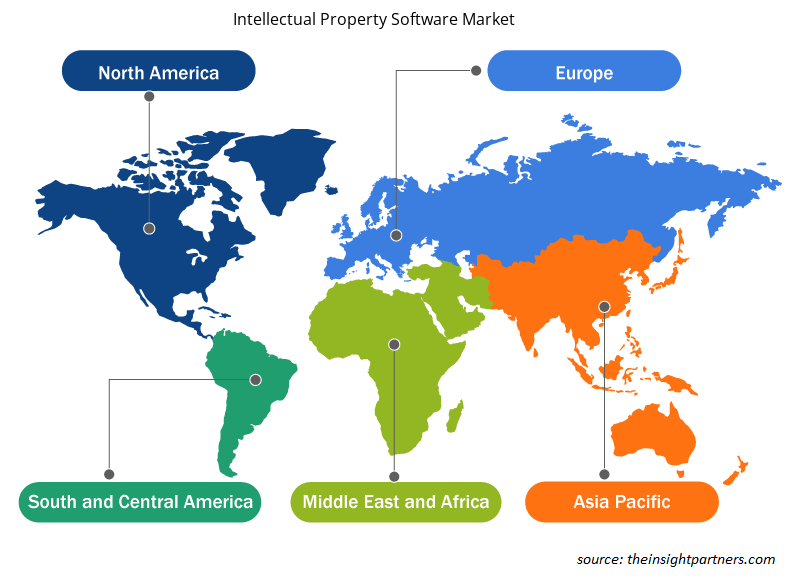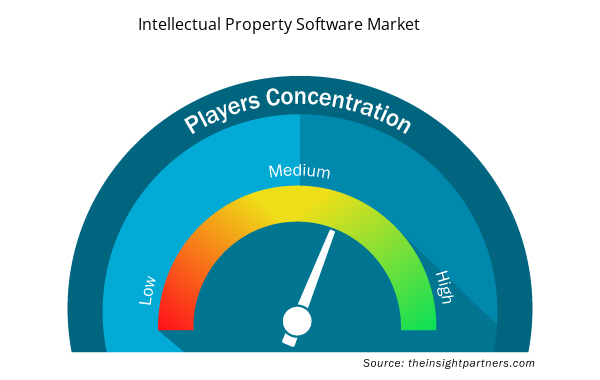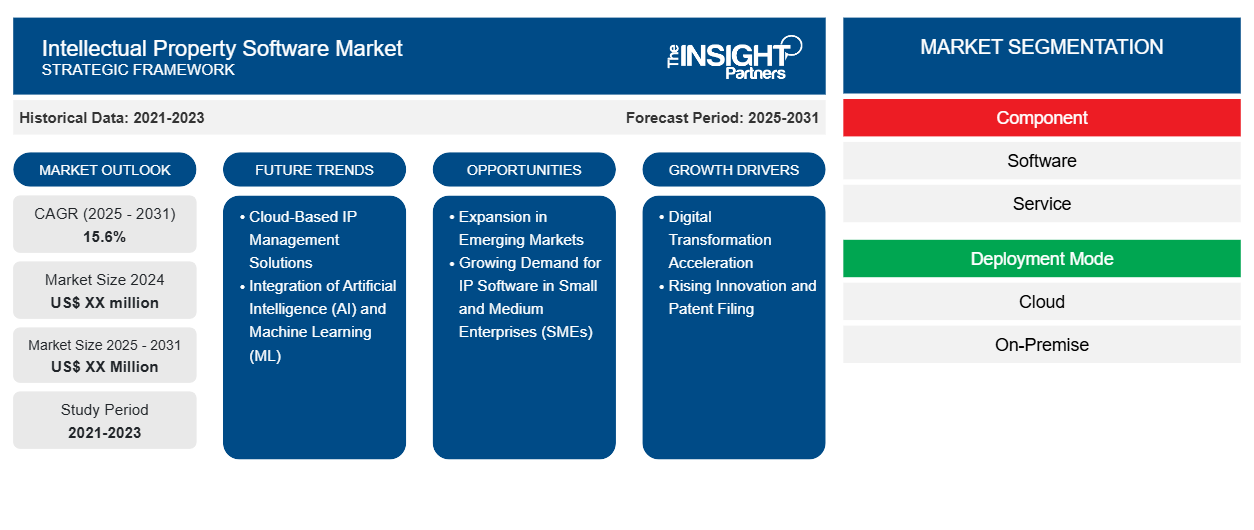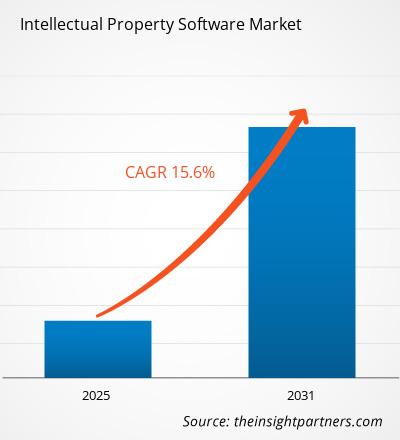من المتوقع أن يسجل سوق برمجيات الملكية الفكرية معدل نمو سنوي مركب بنسبة 15.6٪ من عام 2023 إلى عام 2031، مع توسع حجم السوق من XX مليون دولار أمريكي في عام 2023 إلى XX مليون دولار أمريكي بحلول عام 2031.
تم تقسيم التقرير حسب المكون (البرمجيات، الخدمات)؛ وضع النشر (السحابة، في الموقع)؛ التطبيق (إدارة براءات الاختراع، إدارة التجارة، الترخيص، أخرى)؛ المستخدم النهائي (الفرد، الحكومة، الخدمات المصرفية والمالية والتأمين، تكنولوجيا المعلومات والاتصالات، السيارات، الإلكترونيات، التصنيع، التجزئة، الرعاية الصحية، أخرى). تم تقسيم التحليل العالمي بشكل أكبر على المستوى الإقليمي والدول الرئيسية. يقدم التقرير القيمة بالدولار الأمريكي للتحليل والشرائح المذكورة أعلاه
غرض التقرير
يهدف تقرير سوق برمجيات الملكية الفكرية الصادر عن The Insight Partners إلى وصف المشهد الحالي والنمو المستقبلي وأهم العوامل الدافعة والتحديات والفرص. وسيوفر هذا رؤى لمختلف أصحاب المصلحة في الأعمال التجارية، مثل:
- مزودي/مصنعي التكنولوجيا: لفهم ديناميكيات السوق المتطورة ومعرفة فرص النمو المحتملة، وتمكينهم من اتخاذ قرارات استراتيجية مستنيرة.
- المستثمرون: إجراء تحليل شامل للاتجاهات فيما يتعلق بمعدل نمو السوق، وتوقعات السوق المالية، والفرص المتاحة عبر سلسلة القيمة.
- الهيئات التنظيمية: لتنظيم السياسات ومراقبة الأنشطة في السوق بهدف تقليل الانتهاكات والحفاظ على ثقة المستثمرين ودعم سلامة السوق واستقرارها.
تقسيم سوق برمجيات الملكية الفكرية
عنصر
- برمجة
- خدمة
وضع النشر
- سحاب
- في الموقع
طلب
- إدارة براءات الاختراع
- إدارة التجارة
- الترخيص
- آحرون
المستخدم النهائي
- فردي
- حكومة
- الخدمات المالية والمصرفية والتأمين
- تكنولوجيا المعلومات والاتصالات
- السيارات
- الالكترونيات
- تصنيع
- بيع بالتجزئة
- الرعاية الصحية
- آحرون
المستخدم النهائي
- فردي
- حكومة
- الخدمات المالية والمصرفية والتأمين
- تكنولوجيا المعلومات والاتصالات
- السيارات
- الالكترونيات
- تصنيع
- بيع بالتجزئة
- الرعاية الصحية
- آحرون
قم بتخصيص هذا التقرير ليناسب متطلباتك
ستحصل على تخصيص لأي تقرير - مجانًا - بما في ذلك أجزاء من هذا التقرير، أو تحليل على مستوى الدولة، وحزمة بيانات Excel، بالإضافة إلى الاستفادة من العروض والخصومات الرائعة للشركات الناشئة والجامعات
- احصل على أهم اتجاهات السوق الرئيسية لهذا التقرير.ستتضمن هذه العينة المجانية تحليلاً للبيانات، بدءًا من اتجاهات السوق وحتى التقديرات والتوقعات.
محركات نمو سوق برمجيات الملكية الفكرية
- تسريع التحول الرقمي: إن التحول الرقمي السريع عبر الصناعات المختلفة يدفع إلى زيادة الطلب على برامج إدارة الملكية الفكرية القوية. وتسعى الشركات إلى إيجاد حلول متطورة لحماية أصولها المبتكرة وتتبعها وتحقيق الدخل منها في سوق عالمية متزايدة التعقيد والتنافسية.
- الابتكار المتزايد وتسجيل براءات الاختراع: إن الاستثمار المتزايد في البحث والتطوير، وخاصة في مجال التكنولوجيا والأدوية والقطاعات الناشئة، يدفع إلى الحاجة إلى أدوات شاملة لإدارة الملكية الفكرية. وتدرك المنظمات بشكل متزايد القيمة الاستراتيجية لتتبع براءات الاختراع وحمايتها بشكل منهجي.
الاتجاهات المستقبلية لسوق البرمجيات المتعلقة بالملكية الفكرية
- حلول إدارة الملكية الفكرية المستندة إلى السحابة: إن التبني المتزايد للمنصات المستندة إلى السحابة يحول طريقة إدارة الملكية الفكرية والوصول إليها. تمكن برامج الملكية الفكرية المستندة إلى السحابة المؤسسات من تخزين وإدارة والتعاون على محافظ الملكية الفكرية الخاصة بها من أي مكان، مما يقلل من الحاجة إلى البنية الأساسية المحلية ويحسن الوصول للفرق البعيدة أو الموزعة. توفر الحلول السحابية أيضًا إمكانية التوسع، مما يسمح للشركات بتنمية محافظ الملكية الفكرية الخاصة بها دون القلق بشأن قيود التخزين. بالإضافة إلى ذلك، غالبًا ما تأتي الحلول المستندة إلى السحابة مع ميزات أمان متقدمة لضمان حماية بيانات الملكية الفكرية الحساسة، مما يجعلها خيارًا جذابًا للشركات التي تسعى إلى المرونة والتعاون والأمان المعزز في عمليات إدارة الملكية الفكرية الخاصة بها.
- دمج الذكاء الاصطناعي والتعلم الآلي: يتم دمج الذكاء الاصطناعي والتعلم الآلي بشكل متزايد في برامج الملكية الفكرية لأتمتة المهام الروتينية وتحسين الدقة وتعزيز عملية اتخاذ القرار. على سبيل المثال، يمكن للأدوات التي تعمل بالذكاء الاصطناعي تصنيف براءات الاختراع تلقائيًا، والتنبؤ بمخاطر انتهاك براءات الاختراع، أو المساعدة في البحث عن براءات الاختراع وتحليلها من خلال تحديد الفن السابق. تُستخدم خوارزميات التعلم الآلي أيضًا لتحليل اتجاهات براءات الاختراع، وتتبع أنشطة المنافسين، وتحديد التقنيات الناشئة، مما يسمح للشركات باتخاذ قرارات تعتمد على البيانات فيما يتعلق باستراتيجيات الملكية الفكرية الخاصة بها. أصبح دمج الذكاء الاصطناعي والتعلم الآلي في حلول برامج الملكية الفكرية اتجاهًا رئيسيًا، مما يجعل إدارة الملكية الفكرية أكثر كفاءة وتنبؤًا واستباقية.
فرص سوق البرمجيات ذات الملكية الفكرية
- التوسع في الأسواق الناشئة: مع تزايد التصنيع والابتكار في الأسواق الناشئة مثل الهند والصين وجنوب شرق آسيا، تركز الشركات في هذه المناطق بشكل متزايد على حماية ملكيتها الفكرية. وتتزايد الحاجة إلى برامج إدارة الملكية الفكرية الفعّالة مع إدراك الشركات في هذه الأسواق لقيمة براءات الاختراع والعلامات التجارية وحقوق التأليف والنشر في المنافسة العالمية. ومع التعقيد المتزايد لقوانين الملكية الفكرية المحلية وأنظمة تقديم ملفات الملكية الفكرية الدولية، تتاح لمقدمي برامج الملكية الفكرية فرصة لتوسيع عروضهم في هذه المناطق من خلال توفير حلول مخصصة ومحلية تلبي الاحتياجات المحددة للشركات في الأسواق الناشئة.
- الطلب المتزايد على برامج الملكية الفكرية في الشركات الصغيرة والمتوسطة الحجم: تقليديًا، كانت الشركات الكبيرة هي المستخدم الرئيسي لبرامج إدارة الملكية الفكرية المتطورة. ومع ذلك، مع استمرار الشركات الصغيرة والمتوسطة الحجم في الابتكار والتوسع عالميًا، فإنها تدرك أيضًا أهمية أدوات إدارة الملكية الفكرية القوية. تكافح العديد من الشركات الصغيرة والمتوسطة الحجم لإدارة أصول الملكية الفكرية الخاصة بها بشكل فعال بسبب الموارد المحدودة والافتقار إلى المعرفة المتخصصة. هناك فرصة كبيرة لموردي برامج الملكية الفكرية لتقديم حلول ميسورة التكلفة وقابلة للتطوير وسهلة الاستخدام ومصممة خصيصًا لتلبية احتياجات الشركات الصغيرة والمتوسطة الحجم. يمكن أن تساعد هذه الحلول الشركات الصغيرة والمتوسطة الحجم في حماية ابتكاراتها، والتنقل عبر أنظمة الملكية الفكرية الدولية، وتحقيق الدخل من أصول الملكية الفكرية الخاصة بها دون التعقيد والتكلفة المرتبطة عادةً ببرامج مستوى المؤسسة.
رؤى إقليمية حول سوق البرمجيات المتعلقة بالملكية الفكرية
لقد قام المحللون في Insight Partners بشرح الاتجاهات والعوامل الإقليمية المؤثرة على سوق برامج الملكية الفكرية طوال فترة التوقعات بشكل شامل. يناقش هذا القسم أيضًا قطاعات سوق برامج الملكية الفكرية والجغرافيا في جميع أنحاء أمريكا الشمالية وأوروبا ومنطقة آسيا والمحيط الهادئ والشرق الأوسط وأفريقيا وأمريكا الجنوبية والوسطى.

- احصل على البيانات الإقليمية المحددة لسوق برمجيات الملكية الفكرية
نطاق تقرير سوق برمجيات الملكية الفكرية
| سمة التقرير | تفاصيل |
|---|---|
| حجم السوق في عام 2023 | XX مليون دولار أمريكي |
| حجم السوق بحلول عام 2031 | XX مليون دولار أمريكي |
| معدل النمو السنوي المركب العالمي (2023 - 2031) | 15.6% |
| البيانات التاريخية | 2021-2022 |
| فترة التنبؤ | 2024-2031 |
| القطاعات المغطاة | حسب المكون
|
| المناطق والدول المغطاة | أمريكا الشمالية
|
| قادة السوق وملفات تعريف الشركات الرئيسية |
|
كثافة اللاعبين في سوق البرمجيات المتعلقة بالملكية الفكرية: فهم تأثيرها على ديناميكيات الأعمال
يشهد سوق برامج الملكية الفكرية نموًا سريعًا، مدفوعًا بالطلب المتزايد من المستخدم النهائي بسبب عوامل مثل تفضيلات المستهلك المتطورة والتقدم التكنولوجي والوعي المتزايد بفوائد المنتج. ومع ارتفاع الطلب، تعمل الشركات على توسيع عروضها والابتكار لتلبية احتياجات المستهلكين والاستفادة من الاتجاهات الناشئة، مما يؤدي إلى زيادة نمو السوق.
تشير كثافة اللاعبين في السوق إلى توزيع الشركات أو المؤسسات العاملة في سوق أو صناعة معينة. وهي تشير إلى عدد المنافسين (اللاعبين في السوق) الموجودين في مساحة سوق معينة نسبة إلى حجمها أو قيمتها السوقية الإجمالية.
الشركات الرئيسية العاملة في سوق برمجيات الملكية الفكرية هي:
- شركة أيستيموس المحدودة
- شركة أناكوا
- المحاسب العام المعتمد العالمي
- جيمالتو (مجموعة تاليس)
- شركة جريدلوجيكس تكنولوجيز المحدودة
إخلاء المسؤولية : الشركات المذكورة أعلاه ليست مرتبة بأي ترتيب معين.

- احصل على نظرة عامة على أهم اللاعبين الرئيسيين في سوق برمجيات الملكية الفكرية
نقاط البيع الرئيسية
- التغطية الشاملة: يغطي التقرير بشكل شامل تحليل المنتجات والخدمات والأنواع والمستخدمين النهائيين لسوق برامج الملكية الفكرية، مما يوفر صورة شاملة.
- تحليل الخبراء: تم تجميع التقرير على أساس الفهم العميق لخبراء الصناعة والمحللين.
- معلومات محدثة: يضمن التقرير أهمية الأعمال التجارية بسبب تغطيته للمعلومات الحديثة واتجاهات البيانات.
- خيارات التخصيص: يمكن تخصيص هذا التقرير لتلبية متطلبات العملاء المحددة وبما يتناسب مع استراتيجيات العمل بشكل مناسب.
وبالتالي، يمكن أن يساعد تقرير البحث حول سوق البرمجيات ذات الملكية الفكرية في تمهيد الطريق لفك شفرة وفهم سيناريو الصناعة وآفاق النمو. ورغم وجود بعض المخاوف المشروعة، فإن الفوائد الإجمالية لهذا التقرير تميل إلى التفوق على العيوب.
- التحليل التاريخي (سنتان)، السنة الأساسية، التوقعات (7 سنوات) مع معدل النمو السنوي المركب
- تحليل PEST و SWOT
- حجم السوق والقيمة / الحجم - عالميًا وإقليميًا وقطريًا
- الصناعة والمنافسة
- مجموعة بيانات Excel


- High Speed Cable Market
- Artificial Turf Market
- Drain Cleaning Equipment Market
- Aircraft MRO Market
- UV Curing System Market
- Smart Mining Market
- Public Key Infrastructure Market
- Excimer & Femtosecond Ophthalmic Lasers Market
- Lyophilization Services for Biopharmaceuticals Market
- Wind Turbine Composites Market

Report Coverage
Revenue forecast, Company Analysis, Industry landscape, Growth factors, and Trends

Segment Covered
This text is related
to segments covered.

Regional Scope
North America, Europe, Asia Pacific, Middle East & Africa, South & Central America

Country Scope
This text is related
to country scope.
الأسئلة الشائعة
Some of the customization options available based on the request are an additional 3-5 company profiles and country-specific analysis of 3-5 countries of your choice. Customizations are to be requested/discussed before making final order confirmation# as our team would review the same and check the feasibility
The report can be delivered in PDF/PPT format; we can also share excel dataset based on the request
Cloud-based IP management solutions is anticipated to play a significant role in the global intellectual property software market in the coming years
Digital transformation acceleration and rising innovation and patent filing are the major factors driving the intellectual property software market
The Intellectual Property Software Market is estimated to witness a CAGR of 15.6% from 2023 to 2031
Trends and growth analysis reports related to Technology, Media and Telecommunications : READ MORE..
1. Aistemos Ltd
2. Anaqua, Inc.
3. CPA Global
4. Gemalto (Thales Group)
5. Gridlogics Technologies Pvt. Ltd.
6. Innovation Asset Group, Inc.
7. Inteum Company, LLC
8. Patrix AB
9. PatSnap
10. WebTMS Ltd
The Insight Partners performs research in 4 major stages: Data Collection & Secondary Research, Primary Research, Data Analysis and Data Triangulation & Final Review.
- Data Collection and Secondary Research:
As a market research and consulting firm operating from a decade, we have published and advised several client across the globe. First step for any study will start with an assessment of currently available data and insights from existing reports. Further, historical and current market information is collected from Investor Presentations, Annual Reports, SEC Filings, etc., and other information related to company’s performance and market positioning are gathered from Paid Databases (Factiva, Hoovers, and Reuters) and various other publications available in public domain.
Several associations trade associates, technical forums, institutes, societies and organization are accessed to gain technical as well as market related insights through their publications such as research papers, blogs and press releases related to the studies are referred to get cues about the market. Further, white papers, journals, magazines, and other news articles published in last 3 years are scrutinized and analyzed to understand the current market trends.
- Primary Research:
The primarily interview analysis comprise of data obtained from industry participants interview and answers to survey questions gathered by in-house primary team.
For primary research, interviews are conducted with industry experts/CEOs/Marketing Managers/VPs/Subject Matter Experts from both demand and supply side to get a 360-degree view of the market. The primary team conducts several interviews based on the complexity of the markets to understand the various market trends and dynamics which makes research more credible and precise.
A typical research interview fulfils the following functions:
- Provides first-hand information on the market size, market trends, growth trends, competitive landscape, and outlook
- Validates and strengthens in-house secondary research findings
- Develops the analysis team’s expertise and market understanding
Primary research involves email interactions and telephone interviews for each market, category, segment, and sub-segment across geographies. The participants who typically take part in such a process include, but are not limited to:
- Industry participants: VPs, business development managers, market intelligence managers and national sales managers
- Outside experts: Valuation experts, research analysts and key opinion leaders specializing in the electronics and semiconductor industry.
Below is the breakup of our primary respondents by company, designation, and region:

Once we receive the confirmation from primary research sources or primary respondents, we finalize the base year market estimation and forecast the data as per the macroeconomic and microeconomic factors assessed during data collection.
- Data Analysis:
Once data is validated through both secondary as well as primary respondents, we finalize the market estimations by hypothesis formulation and factor analysis at regional and country level.
- Macro-Economic Factor Analysis:
We analyse macroeconomic indicators such the gross domestic product (GDP), increase in the demand for goods and services across industries, technological advancement, regional economic growth, governmental policies, the influence of COVID-19, PEST analysis, and other aspects. This analysis aids in setting benchmarks for various nations/regions and approximating market splits. Additionally, the general trend of the aforementioned components aid in determining the market's development possibilities.
- Country Level Data:
Various factors that are especially aligned to the country are taken into account to determine the market size for a certain area and country, including the presence of vendors, such as headquarters and offices, the country's GDP, demand patterns, and industry growth. To comprehend the market dynamics for the nation, a number of growth variables, inhibitors, application areas, and current market trends are researched. The aforementioned elements aid in determining the country's overall market's growth potential.
- Company Profile:
The “Table of Contents” is formulated by listing and analyzing more than 25 - 30 companies operating in the market ecosystem across geographies. However, we profile only 10 companies as a standard practice in our syndicate reports. These 10 companies comprise leading, emerging, and regional players. Nonetheless, our analysis is not restricted to the 10 listed companies, we also analyze other companies present in the market to develop a holistic view and understand the prevailing trends. The “Company Profiles” section in the report covers key facts, business description, products & services, financial information, SWOT analysis, and key developments. The financial information presented is extracted from the annual reports and official documents of the publicly listed companies. Upon collecting the information for the sections of respective companies, we verify them via various primary sources and then compile the data in respective company profiles. The company level information helps us in deriving the base number as well as in forecasting the market size.
- Developing Base Number:
Aggregation of sales statistics (2020-2022) and macro-economic factor, and other secondary and primary research insights are utilized to arrive at base number and related market shares for 2022. The data gaps are identified in this step and relevant market data is analyzed, collected from paid primary interviews or databases. On finalizing the base year market size, forecasts are developed on the basis of macro-economic, industry and market growth factors and company level analysis.
- Data Triangulation and Final Review:
The market findings and base year market size calculations are validated from supply as well as demand side. Demand side validations are based on macro-economic factor analysis and benchmarks for respective regions and countries. In case of supply side validations, revenues of major companies are estimated (in case not available) based on industry benchmark, approximate number of employees, product portfolio, and primary interviews revenues are gathered. Further revenue from target product/service segment is assessed to avoid overshooting of market statistics. In case of heavy deviations between supply and demand side values, all thes steps are repeated to achieve synchronization.
We follow an iterative model, wherein we share our research findings with Subject Matter Experts (SME’s) and Key Opinion Leaders (KOLs) until consensus view of the market is not formulated – this model negates any drastic deviation in the opinions of experts. Only validated and universally acceptable research findings are quoted in our reports.
We have important check points that we use to validate our research findings – which we call – data triangulation, where we validate the information, we generate from secondary sources with primary interviews and then we re-validate with our internal data bases and Subject matter experts. This comprehensive model enables us to deliver high quality, reliable data in shortest possible time.


 احصل على عينة مجانية لهذا التقرير
احصل على عينة مجانية لهذا التقرير